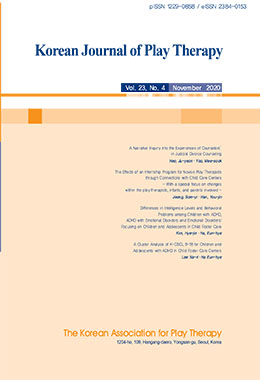본 연구에서는 복지시설 ADHD 아동 청소년을 대상으로 K-CBCL 6-18 문제행동 증후군 척도를 군집분석하여 군집별 특성을 확인하였다. 연구 대상은 아동복지시설 ADHD 초중학생이며 154명이다. 연구도구는 K-CBCL 6-18 아동ㆍ청소년 행동평가척도, 한국판 ADHD 평가척도를 사용하였다. 연구의 결과는 다음과 같다. 첫째, 복지시설 ADHD 아동ㆍ청소년 대상으로 CBCL 문제행동 소척도를 군집 분석한 결과, ‘낮은 문제 행동 군집’, ‘외현화 문제 군집’, ‘품행 문제 군집’, ‘혼합형 문제 군집’으로 산출되었다. 둘째, 각 군집의 특성을 파악하기 위해서 하위 군집에 따른 CBCL의 DSM 진단척도, 문제행동 특수 척도, 적응척도의 차이를 분석한 결과로 DSM 품행문제와 DSM 반항행동문제 척도는 ‘품행 문제 군집’에서 점수가 가장 높았고, 적응 척도에서 ‘낮은 문제 행동 군집’과 ‘외현화 문제 군집’이 높은 적응 척도 점수를 보였다. 셋째, 하위 군집의 특성을 파악하기 위해서 다양한 심리 척도를 비교한 결과, K-ARS 하위 척도 모두 군집 간 차이가 유의하였고, ‘품행 문제 군집’이 가장 높은 점수였다. 이와 같이 본 연구에서는 복지시설 ADHD 아동ㆍ청소년의 K-CBCL 6-18 프로파일 하위 군집을 산출하고 하위군집별 특성을 규명하는데 의의가 있다.
In this study, we analyzed the K-CBCL 6-18 problem behavior syndrome scale using cluster analysis for children and adolescents with ADHD in child foster care centers. The study subjects comprised 154 students with ADHD. The research instruments used were the K-CBCL 6-18, and the K-ARS. The results of this study were as follows. First, the CBCL problem behaviors subscale of the ADHD observed in child foster care centers was classified in the following clusters: a ‘low problem behavior cluster(1)’, an ‘externalization problem cluster(2)’, a ‘conduct problem cluster(3)’ and a ‘mixed problem cluster(4)’. Second, in order to analyze the characteristics of each cluster, we analyzed the differences of the CBCL DSM diagnostic scale, the problem behavior special scale, and the adaptation scale. As a result, the DSM behavior problem and the DSM rebellion behavior of behavior problem cluster(3) were the highest in the clusters. Moreover, the ‘low problem behavior cluster(1)’ and the ‘externalization problem cluster(2)’ in the adaptation scale showed a high adaptation scale score. Third, in order to understand the psychological characteristics of these clusters, we compared a number of different psychological scales. The K-ARS subscales were significantly different from those of the other psychological scales and the ‘behavior problem cluster(3)’ scored the highest score in the K-ARS. Thus, through this study, we were able to classify the CBCL sub-cluster profiles of children and adolescents in child foster care centers and identify the characteristics of each sub-cluster.




